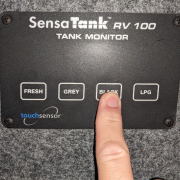Offering a New Service, Sort of by Accident
Our Tank Sensors Stopped Working
As often happens, a problem with our own motorhome pushed us into doing another “we’ll never do that” service. Like just about everyone else, our black tank sensors eventually started reading 3/4 just about all the time, no matter what was really in there. Our tank sensors are on the outside of the tank, so there’s really only one thing that will cause that a good flush won’t fix: struvite. Struvite is commonly referred to as “kidney stones outside the body” and naturally accumulates anywhere there is human waste. Waste treatment plants spend a large portion of their budget every year just keeping a handle on this stuff. It forms sheets like a sandy shale that first coats the bottom of the tank and then creeps up the sides. When it reaches the sensors, whether inside or out, they can no longer do their job. Most struvite is found in black tanks, but it’s not unheard of to see some flushed from the grey tank as well.
What’s the Fix?
The only answer for an RV waste holding tank is something called a hydro-jet deep cleanse. This is the process of basically power washing the inside of the tank using some specialized tools. Done on both black and grey tanks, it blasts out the struvite, soap scum, bacon fat, black mold, roaches, and other things that should’ve never been in there. It’s definitely something we can do as Certified Advanced RV Repair Technicians, but dang. Almost nobody is wired to enjoy working with poo. Just the same, one of the commitments we made before we went pro was to not pay someone else to do what we were paying so much to be able to do ourselves.
So We Did a Thing
A quick shopping spree later and we were exploring the treasures of our holding tanks. Since we’re well trained on such things, our tanks were thankfully free of all but the impossible to control, namely struvite in the black tank and black mold in the grey tank. Both tanks were dumped and filled with fresh water (our camper has a flush system), and dumped again, but the amount of material that came out of these tanks with the hydro-jet was shocking. It hasn’t been done to this camper since we bought it 2 or so years ago and who knows when (if ever) it was done before that.
The end result was better than we’d hoped. Our black tank sensors now work again. As a bonus, our grey water is now completely odorless except for a slight hint of the fruity shampoo Michelle likes.
Now What?
So now we have this equipment we never wanted and can do this thing that we never wanted to do. Should we offer this as a service to others? Remember the healthy natural aversion to working with poo? Well, your own poo can’t generally make you sick. That is, however, a definite risk when working with other people’s poo. On the other hand, this is the single most turned down request we get. It would be good to stop saying, “Sorry, I can’t help you with that.”
Is This DIY Maintenance?
On a side note, “Sorry,” is all we can say because we would absolutely never recommend someone run out and buy the equipment to try it themselves. A prerequisite of doing the job is a full understanding, from the inside out, what the waste system is made of, and how those parts are assembled. Beyond that, you either have the finesse to get the tools in and out of there without getting them stuck, or you don’t. There’s no good way to describe all the sensations required to blindly navigate the plumbing to get the tool into the tank, but if you fail at that, it just means you can’t finish the job. Where things turn super ugly is getting the tool into the tank and then it gets stuck. If that happens, you better have the skills to start taking things apart from the belly up and the stomach to reach into scary places, because just leaving the tool in there will pretty quickly make the system unusable.
Our Decision and Why
Anyways, we now officially offer this service. The deciding factor was our original commitment to serving the full-time community and that is the most impacted segment out there.
It is “recommended” (especially by people who offer this service exclusively) to have this done annually. We don’t want to start any industry in-fighting, but we won’t be recommending that to anyone who uses their RV for traditional recreational purposes. Unless there’s evidence of a problem, hydro-jetting tanks is more of a repair item than a maintenance item. It will generally wait until there’s a reason to do it, sensor problems, smells, clogs, that sort of thing. Many RVs make it to the junkyard having NEVER needed a waste tank deep cleaning.
The full-time community, however, has different concerns. These wastewater systems were designed to handle simply holding waste for a weekend or occasionally for a week. The struvite build up would take years to affect anything under that use case. But when living in an RV, the waste tanks are under special strains. (It is important that in all use cases, the tanks remain closed until ready to dump, but that’s another topic.) With material being in the tanks 365 days a year rather than only, say 36 days a year (which would be pretty heavy usage for most recreational users), that amounts to a decade of buildup every year!
Added to the increased impact of usability problems on full-timers making an ounce of prevention worth several pounds of cure, periodic deep cleaning is definitely required maintenance. The frequency of that maintenance is up to the full-timer. There are differences in conditions that can’t be simply boiled down to “every year” for this one. A family with 2 (or more) children might find it comforting to get it done twice a year and never worry about those tanks. An experienced retired couple might find that their excellent tank maintenance skills will let them stretch it out to every couple of years. Others might roll the dice and wait for the situation to be untenable before spending the money. Every answer is correct for the person making the decision.

